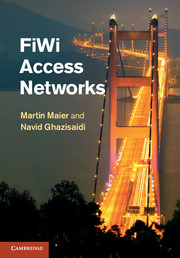Book contents
- Frontmatter
- Contents
- List of figures
- List of tables
- Preface
- Acknowledgments
- Part I Introduction
- Part II Fiber access networks
- Part III Wireless access networks
- Part IV FiWi access networks
- 10 RoF vs. R&F networks
- 11 Architectures
- 12 Network planning and reconfiguration
- 13 Techno-economic analysis
- 14 Network coding
- 15 Optical and wireless protection
- 16 Hierarchical frame aggregation
- 17 Routing and QoS continuity
- 18 Smart grid communications
- References
- Index
15 - Optical and wireless protection
from Part IV - FiWi access networks
Published online by Cambridge University Press: 05 January 2012
- Frontmatter
- Contents
- List of figures
- List of tables
- Preface
- Acknowledgments
- Part I Introduction
- Part II Fiber access networks
- Part III Wireless access networks
- Part IV FiWi access networks
- 10 RoF vs. R&F networks
- 11 Architectures
- 12 Network planning and reconfiguration
- 13 Techno-economic analysis
- 14 Network coding
- 15 Optical and wireless protection
- 16 Hierarchical frame aggregation
- 17 Routing and QoS continuity
- 18 Smart grid communications
- References
- Index
Summary
Fiber-to-the-home (FTTH) or close to it (FTTx) networks are poised to become the next major success story for optical fiber communications. Future FTTx access networks unleash the economic potential and societal benefit by opening up the first/last mile bandwidth bottleneck between bandwidth-hungry end-users and high-speed backbone networks. Owing to their longevity, low attenuation, and huge bandwidth, passive optical networks (PONs) are widely deployed to realize cost-effective FTTx access networks. Fiber has been envisioned for delivering broadband services for over 30 years. However, many roadblocks related to component and installation costs have slowed down the progress toward FTTx since it was first proposed. Currently, FTTH is being installed in many countries, but it still represents only a fraction of all deployed broadband lines (Shumate [2008]). The two major state-of-the-art PON standards IEEE 802.3ah Ethernet PON (EPON) and ITU-T G.984 Gigabit PON (GPON) consist both of a single upstream wavelength channel and a separate single downstream wavelength channel, whereby both channels are operated using time division multiplexing (TDM). EPON and GPON are expected to coexist for the foreseeable future as they evolve into next-generation PONs (NG-PONs) (Effenberger et al. [2007], Kazovsky et al. [2007]).
NG-PONs can be categorized into high-speed TDM PON, wavelength division multiplexing (WDM) PON, and long-reach PON (LR-PON) (Lin [2008], Effenberger et al. [2009a]).
- Type
- Chapter
- Information
- FiWi Access Networks , pp. 171 - 186Publisher: Cambridge University PressPrint publication year: 2011



